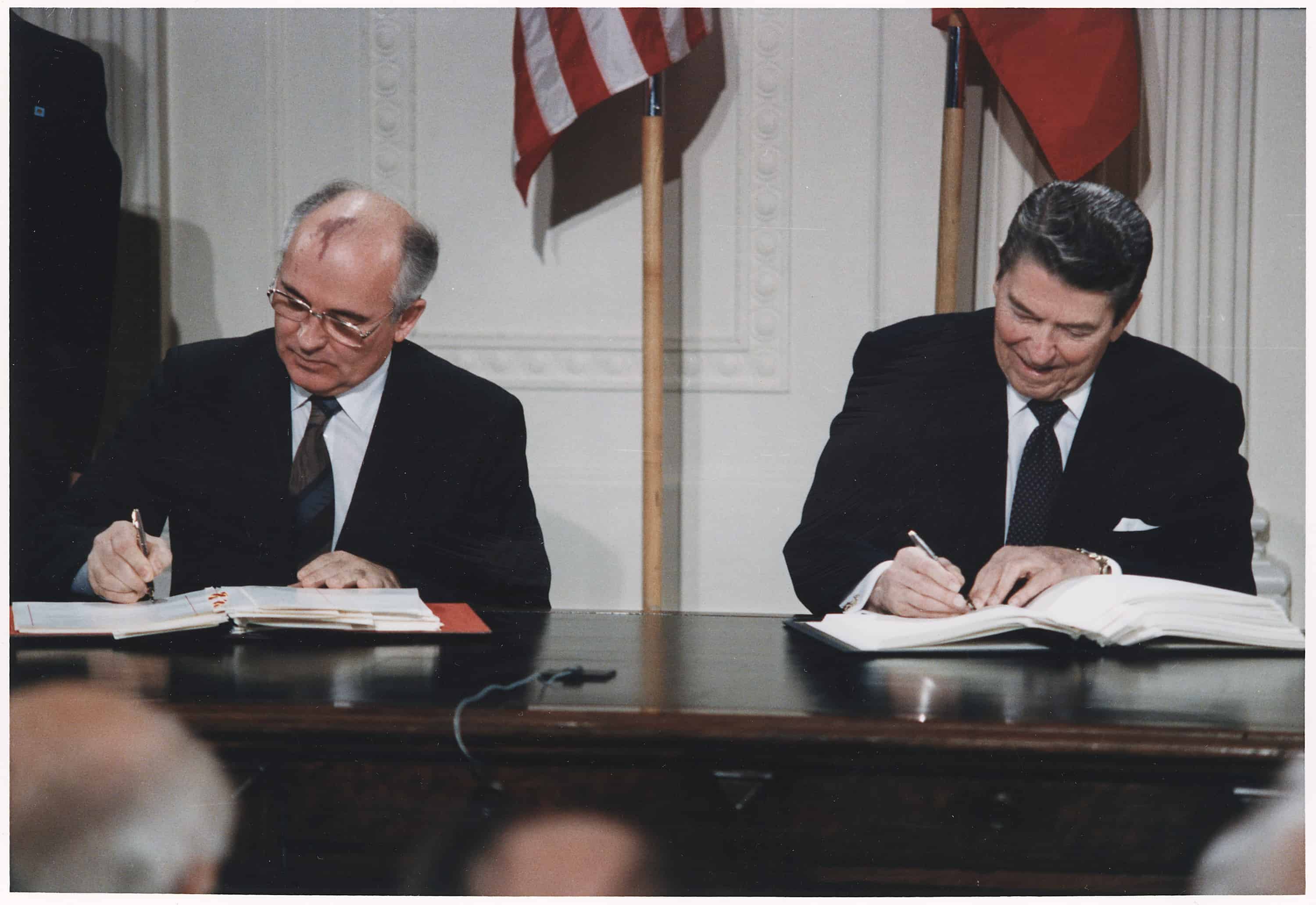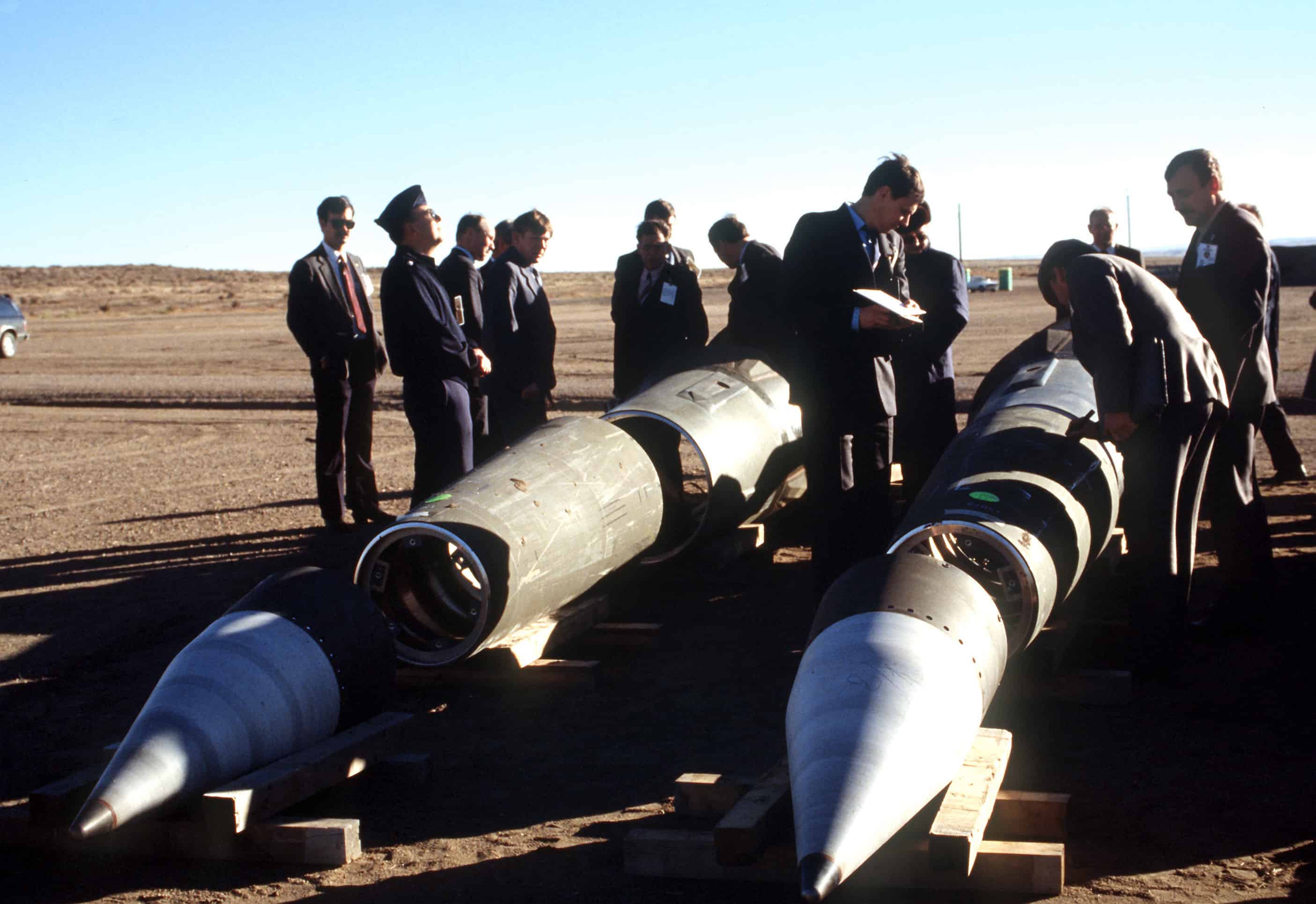The Intermediate-Range Nuclear Forces Treaty (INF) is an arms-control agreement signed on 8th December 1987 in Washington D.C., by the then U.S. President Ronald Reagan and the Soviet Union General Secretary Mikhail Gorbachev. It entered into force in June 1988 and it was considered one of the major achievements for bringing an end to the nuclear race between the U.S. and Soviet Union.
 With the INF the U.S. and Soviet Union agreed to gradually eliminate the stocks of intermediate-range and shorter-range (or “medium range”) land-based missiles. The treaty defined as “intermediate-range ballistic missiles” (IRBMs) and “ground-launched cruise missiles” (GLCMs) the missiles having ranges of 1,000 to 5,500km (620 to 3,400 miles) and as shorter-range ballistic missiles (SRBMs) the missiles having a range of 500 to 1,000km.
With the INF the U.S. and Soviet Union agreed to gradually eliminate the stocks of intermediate-range and shorter-range (or “medium range”) land-based missiles. The treaty defined as “intermediate-range ballistic missiles” (IRBMs) and “ground-launched cruise missiles” (GLCMs) the missiles having ranges of 1,000 to 5,500km (620 to 3,400 miles) and as shorter-range ballistic missiles (SRBMs) the missiles having a range of 500 to 1,000km.
The INF ban originally applied only to U.S. and Soviet forces, but the treaty’s membership expanded in 1991 to include successor states of the former Soviet Union. Today, also Belarus, Kazakhstan, and Ukraine join Russia and the United States in the treaty’s implementation.
How the Intermediate-Range Nuclear Forces Treaty come into force
In late 1970s, the Soviet Union started replacing old single-warhead SS-4 and SS-5 IRBMs with SS-20s which could deliver three nuclear war-heads apiece from a distance of 5,000km. SS-20s could strike target anywhere in Western Europe in less than 10 minutes. This became a cause of concern for the Western European countries.
With the pressure from NATO (North Atlantic Treaty Organization), U.S. committed itself to deploying two intermediate-range weapons system of its own in Western Europe. The weapons system was- the Pershing II and Tomahawk Cruise missile. The Pershing II was an IRBM which could carry a single nuclear warhead at a distance of about 2,000km and strike within the vicinity of Moscow in less than 10 minutes.
With these nuclear developments from both the sides, political turmoil raised. It was believed that the weapons were not created only for defence purpose.
In October 1980, the INF negotiations began and after five years of interrupted discussions and negotiations, U.S. and Soviet Union began to move in 1986 toward a comprehensive agreement concluded with the signing of Treaty on December 8th, 1987 for the elimination of all superpowers’ intermediate-range and shorter-range missiles. Each country was given the right to conduct periodic inspections for 13 years to ensure complete elimination of the missiles.
Donald Trump announcement that he would “terminate” the INF Treaty
United States President Mr. Donal Trump on Monday, 21st October, announced that U.S. is going to withdraw from the INF pact as Russia has been violating it for many years. The U.S. President said
They have been violating it for many years and we’re not going to let them violate a nuclear agreement and go out and do weapons and we’re not allow to.
Trump also blamed former President Obama for ignoring the violation done by Russia all these years. U.S. argued that Russia has been violating the INF agreement and it is posing a threat to Nato with the development and deployment of a new land-cruise missile. On the other hand, Trump said that China’s arsenal, that is not part of the IFN Treaty, represents also a threat to United States.
We’ll have to develop those weapons, unless Russia comes to us and China comes to us and they all come to us and say let’s really get smart and let’s none of us develop those weapons, but if Russia’s doing it and if China’s doing it, and we’re adhering to the agreement, that’s unacceptable.
What does this could mean for United States and Russia
Since the US has not yet made any move to make an exit from the treaty, many analysts believe that this just might not happen. They also believe that the exit will be a loss for the US and a gain for Russia and believe that this is the masterstroke by Putin which he had been trying for years.
In case of withdrawal of United States, Russia could feel free to conduct their nuclear tests and to develop new nuclear missiles. After the Cold War, Russia had to bow down to the demand of U.S. and had to sign the arms-control treaty which limited the power of Russia and in a way made US the supreme power.
With U.S. moving out of the treaty, Russian military forces have a chance to show their dominance as they have a greater number of short and medium-range missiles at their disposal whereas U.S. will have to develop them, which might take a long time.
Conclusion
If Trump goes ahead and withdraws from the INF, that would leave the Strategic Arms Reduction Treaty (New START) as the last obstacle to uncontrolled nuclear proliferation.
The treaty will expire in 2021, and Washington has not yet decided on renewing it.







